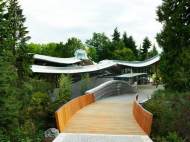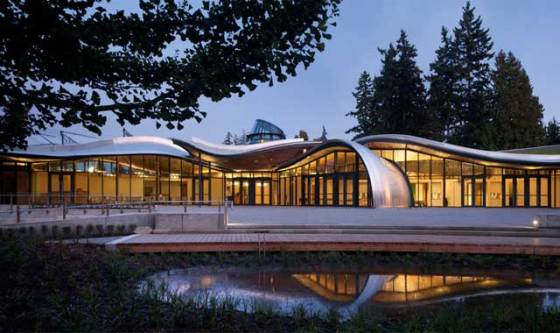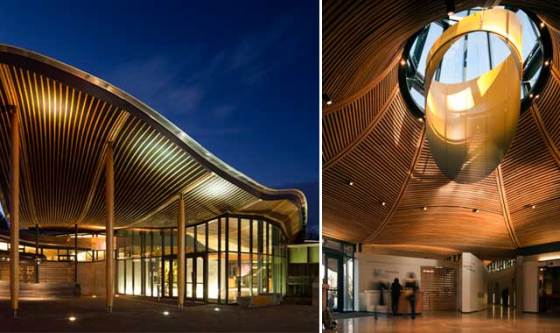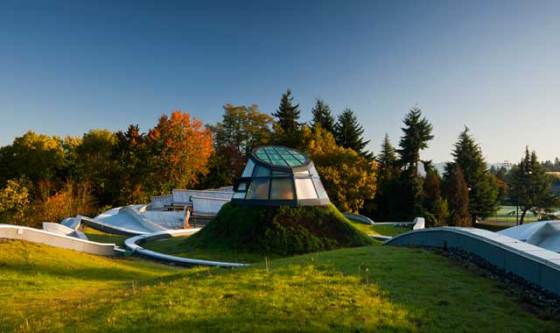Green architecture – VanDusen Botanical Garden Visitor Centre
 Located between Oak Street and Livingstone Lake in an area once occupied by a collection of hollies that have been transferred to other botanical gardens, the VanDusen Botanical Garden Visitor Centre is a great example of Vancouver green architecture . The building exceeds LEED Platinum certification status, and it is designed to meet much stricter Living Building Challenge by International Living Future Institute.
Located between Oak Street and Livingstone Lake in an area once occupied by a collection of hollies that have been transferred to other botanical gardens, the VanDusen Botanical Garden Visitor Centre is a great example of Vancouver green architecture . The building exceeds LEED Platinum certification status, and it is designed to meet much stricter Living Building Challenge by International Living Future Institute.
Designed by Perkins+Will in conjunction with landscape designer Cornelia Hahn Oberlander, the 1,765 square-meter (19,000 square-foot) VanDusen Botanical Garden Visitor Centre presents a great civic landmark and a major tourist attraction. VanDusen‘s collections and education programs help raise awareness of the importance of preserving the earth’s biodiversity, in keeping with the Garden’s plant conservation mandate.
Strategically located in a natural, pastoral woodland setting between the Eastern North American collection and the Pacific Northwest (native plant) collection, the facility pushes the boundaries of what is possible in design and construction. It was inspired by the natural forms of a native orchid, and the green roof appears to be floating over the building which houses a café, library, garden store, classroom and rental space, exhibit room and volunteer lounge.
3D software packages were used to design the building. To some extent they gave designers the vision to conceive the building and its form. The facility creates a healthy interface between people, the garden’s natural flora and the buildings. A bridge made of recovered fir from the former covered walkway at the site leads visitors over a watercourse and the new Cascadia Garden to the visitor centre. This garden showcases plants from the Pacific Northwest with native plants identified by traditional Musqueam names.
Architects chose materials according to their health, carbon footprint, ability to be recycled and their individual life cycles to choose to most appropriate and long-lasting components. Wood is the primary building material, sequestering enough carbon to achieve carbon neutrality. The roof is constructed out of a glue laminated post-and-beam construction.
The building is situated to avoid destroying the rare trees, shrubs and plants around the garden. The roof garden also replaces the vegetation displaced by the building itself and helps reintegrate vegetation into the architecture. The operable glazed glass oculus on the roof produces an atrium space in the interior with a warm orange glow, reflected by the natural wood.
In summer, the oculus and heat sink act as a natural air-conditioner triggered by the outside temperature and the sunlight. The oculus then opens increasing the flow of air inside the Visitor Centre. The solar chimney, when lit at night, acts as a beacon welcoming visitors to the Garden.
Energy needs are supplied by on-site renewable sources – 54 geothermal boreholes that run 60 meters (196 feet) deep, a 75-square-meter (807-square-foot) solar photovoltaic array which produces 11,000 kWh, 400 solar hot water tubes which produce 176,000 kWh – which allow the accomplishment of net-zero energy on an annual basis. Abundance of daylight coming from the atrium and window wall, as well as efficient LED lighting, keeps the low energy needs of the building.
Rainwater is filtered and captured in a 300,000-liter (79,250-gallon) custom cistern built into the land ramp and used for the building’s greywater requirements. All blackwater is treated by an on-site bioreactor and released into a new feature percolation field and garden.
Swale Garden on the main plaza in front of the Visitor Centre is cleansing traffic oils and dirt from storm run-off water takes place in the bio-filtration. Gravity carries the polluted water into a specially designed garden where the oils and dirt are filtered out as the water moves down the grade to storage in a large cistern for non-drinking use in the Visitor Centre.
Among seven more buildings which are expected to achieve Living Building certification next year, four are in Canada including the VanDusen Botanical Garden Visitor Centre.












It looks a bit odd, but it’s perfect for its purpose!
I ♥ this project (^_^)